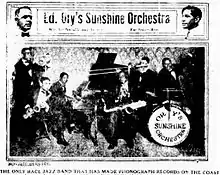Wade Whaley
Wade Whaley (* 22. Februar 1892 in New Orleans, Louisiana; † Februar 1968 in Brooklyn, New York City, New York) war ein US-amerikanischer Jazzmusiker (Klarinette), der mit Bill Johnson und Kid Ory zu den Pionieren des frühen Jazz in Los Angeles gehörte.[1]

Leben und Wirken
Whaley spielte zunächst Kontrabass und Gitarre, bevor er zur Klarinette wechselte. Er hatte 1916 Unterricht bei Lorenzo Tio junior in New Orleans; seine ersten Auftritte hatte er mit Armand Pirons Orchester, das im Temple Theatre auftrat. Er spielte zunächst in lokalen Bands,[2] wie in Jack Careys Crescent Orchestra,[3] 1918 mit Mutt Carey.[4] und John Robichaux.[5] 1917 lud Jelly Roll Morton die Musiker Buddy Petit, Wade Whaley und Frank Dusen ein, Louisiana zu verlassen und Mitglied seiner Band in Los Angeles zu werden.[6] Dort kam es 1918 zu ersten Aufnahmen mit Jelly Roll Morton, Reb Spikes, Mutt Carey und Kid Ory; diese Aufnahmen gelten heute als unauffindbar.[7] Danach kehrte er zunächst nach New Orleans zurück, um 1918 Kid Ory nach Los Angeles zu folgen.[8]
In Los Angeles spielte Whaley von 1919 bis 1925 in Orys Creole Jazz Band mit Mutt Carey.[9] Er wirkte jedoch nicht bei Orys Aufnahmen von 1921 für Sunshine Records mit, wo er von Dink Johnson vertreten wurde.[2] In San Francisco leitete er ab 1925 die Band Black & Tan Jazz Hounds (auch Black & Tan Syncopators). In den frühen 30ern spielte er in einer Theaterband in Capitol Burlesque Hall; um 1934 arbeitete er hauptberuflich als Werftarbeiter in San Jose. Mitte der 1930er-Jahre hatte er eine Band in San Francisco, in der auch der Schlagzeuger Earl Watkins spielte.[10] Im Bereich des Jazz war er erst 1943/44 an acht Aufnahmesessions beteiligt, mit Ory sowie mit Bunk Johnson's V-Disc Veterans (mit Floyd O’Brien, Fred Washington, Frank Pasley, Red Callender, Lee Young).[11] Nach Jimmie Noones Tod 1944 war er dessen Nachfolger in der CBS-Radioshow von Orson Welles.[12]
Diskographische Hinweise
- Kid Ory’s Creole Jazz Band (Folklyric Records, ed. 1975)
- The Mercury All-Stars Jazz Combination: Kid Ory 1944 (Joy Records, ed. 1981)
- Bunk Johnson: In San Francisco (American Music, ed. 1994)
Literatur
- Nicolas Slonimsky, Laura Diane Kuhn: Baker's biographical dictionary of musicians, New York, 2001, S. 649.
Weblinks
- Wade Whaley bei AllMusic (englisch)
- Wade Whaley bei Discogs
Einzelnachweise
- Quintard Taylor: In Search of the Racial Frontier: African Americans in the American West 1528–1990. 1999, Seite 248
- Floyd Levin: Classic Jazz: A Personal View of the Music and the Musicians. 2000.
- Sacramento New Orleans Hot Jazz Society, 1972
- Leonard Feather, Ira Gitler: The Biographical Encyclopedia of Jazz. Oxford University Press, New York 1999, ISBN 0-19-532000-X.
- Samuel Charters: A Trumpet Around the Corner: The Story of New Orleans Jazz. 2008, Seite 57.
- Stephanie Barron, Sheri Bernstein, Ilene Susan Fort: Reading California: Art, Image, and Identity, 1900–2000. 2000, Seite 156.
- George Lipsitz: How Racism Takes Place. 2011, Seite 220
- Thomas J. Hennessey: From Jazz to Swing: African-American Jazz Musicians and Their Music, 1890–1935. 1994, Seite 35.
- Daniel Hardie: Exploring Early Jazz: The Origins and Evolution of the New Orleans Style. 2002, S. 132.
- Leta E. Miller: Music and Politics in San Francisco: From the 1906 Quake to the Second World War. 2012, S. 174.
- Tom Lord: The Jazz Discography (online, abgerufen 6. September 2015)
- Simon Callow: Orson Welles, Volume 2: Hello Americans. 2011, S. 206